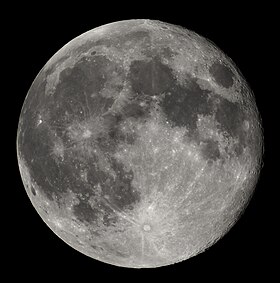The Moon is Earth's only natural satellite and the fifth largest satellite in the Solar System. The average centre-to-centre distance from the Earth to the Moon is 384,403 kilometres (238,857 mi), about thirty times the diameter of the Earth. The common centre of mass of the system (the barycentre) is located at about 1,700 kilometres (1,100 mi)—a quarter the Earth's radius—beneath the surface of the Earth. The Moon makes a complete orbit around the Earth every 27.3 days[nb 3] (the orbital period), and the periodic variations in the geometry of the Earth–Moon–Sun system are responsible for the phases of the Moon, which repeat every 29.5 days[nb 4] (the synodic period).
The Moon's diameter is 3,474 kilometres (2,159 mi)
a little more than a quarter of that of the Earth. Thus, the Moon's surface area is less than a tenth of the Earth (about a quarter of Earth's land area, approximately as large as Russia, Canada, and the United States combined), and its volume is about 2 percent that of Earth. The pull of gravity at its surface is about 17 percent of that at the Earth's surface.
The Moon is the only celestial body on which human beings have made a manned landing. While the Soviet Union's Luna programme was the first to reach the Moon with unmanned spacecraft, the NASA Apollo program achieved the only manned missions to date, beginning with the first manned lunar mission by Apollo 8 in 1968, and six manned lunar landings between 1969 and 1972 – the first being Apollo 11 in 1969. Human exploration of the Moon temporarily ceased with the conclusion of the Apollo program, although a few robotic landers and orbiters have been sent to the Moon since that time. The U.S. has committed to return to the Moon by 2018.[5][6][7] On November 13, 2009, NASA announced the discovery of proof that water exists on the Moon, based on data obtained from the LCROSS lunar impact mission.
No comments:
Post a Comment